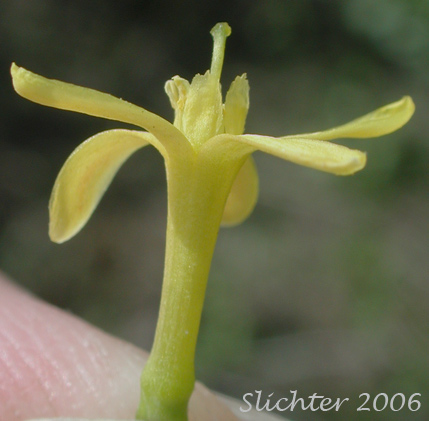 The photo at right shows a close-up sideview of a tubular flower of golden currant as seen at Hog Lake to the east of Sprague, WA.........April 29, 2006.
The photo at right shows a close-up sideview of a tubular flower of golden currant as seen at Hog Lake to the east of Sprague, WA.........April 29, 2006.
Golden currant is an attractive, erect shrub from 1-3 meters tall with smooth stems and shiny green leaves. The leaves are 3-lobed at the tips and wedge-shaped wit the point at the petiole. The lobes may be coarsely or bluntly toothed at their tips, or entire. The leaves are 2-5 cm wide. The surfaces of the older leaves tend to be without hairs, although young leaves may have some hairs present.
The racemes are found on leaf bearing side branches. They are 25-75 mm long with 5-18 flowers. The fragrant flowers are 15-16 mm long with yellow sepals 5-6 mm long and the yellow, orange, or reddish petals about half as long as the sepals. The petals are erect and oblong-obovate in shape. The fruits are smooth-surfaced, and red, black, or yellow in color.
1. Ornamental shrub (somewhat susceptible to the wetter conditions west of the Cascades).
2. Popular plant of insect pollinators during the blooming period.
3. The berries are palatable to both humans and animals
Golden currant may be found along stream banks and in flood plains in the grasslands, ponderosa pine forest, and in the sagebrush desert.
Golden currant may be found from central Washington south along the eastern edge of the Cascades to California and east to southern Alberta, Saskatchewan, and Montana. It has been introduced to British Columbia and may occasionally be found wild there.
In the Columbia River Gorge it may be found between the elevations of 100'-400' from east of Major Creek east to the eastern end of the Gorge.